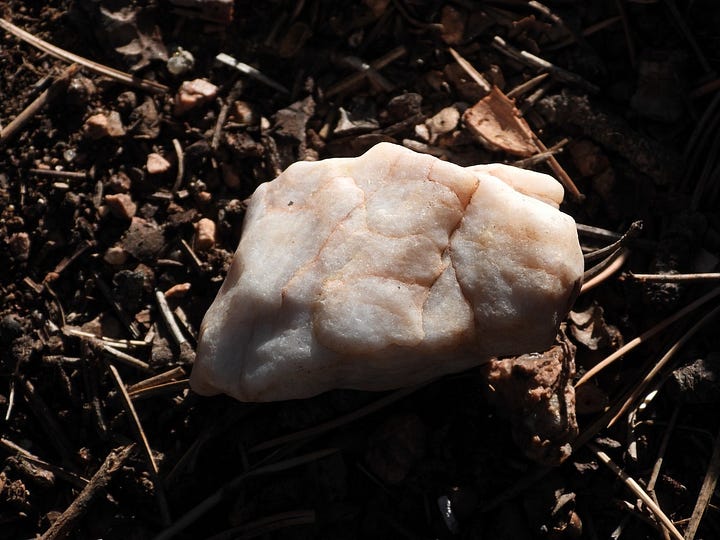



Walk any trail or property path in the Colorado Foothills and you will likely notice the abundance of shiny white rocks among the crumbling granite ground base. Most, you will pass right by, but some are walk-stoppers. Stop, pick it up, see the sheen of sunlight and the colors in the veins throughout the rock. Even the mildly curious may wonder about its story, where it came from, and how it got here. The more character of the rock, the more likely it’s got quite a backstory. It’s been places and gone through some stuff.
In this case, the rock I’m referring to is quartzite. Generally, the most abundant form you will see is the ‘Milky Quartz’ or low-quality quartzite. It seems to ooze out of the ground depositing a lump of white streaked with brown, red, orange, pink, or yellow, finding it where you are sure that it wasn’t there just a few days ago. And, yes, it does have quite a backstory.
The rock you hold is billions of years old, likely part of the Ancestral Rockies (see Jan 8th post). One of the most abundant minerals on earth, quartz is simply silicon and oxygen, silica, the stuff that makes up sand. Vast time, intense heat, and intense pressure caused quartz, deep underground, to compact, melt and change forms repeatedly. A ‘metamorphosis’ you might say. If the quartz undergoes heat and pressure without the mixing of other minerals, it can create a very clear and pure crystal formation. Add in some other minerals, hydrothermal activity, and a bit of radiation underground and you will have many variations, some of which are gemstones such as Amethyst, Citrine, Smoky Quartz, Rose Quartz, Herkimer Diamonds, Rock Crystal, and Chrysoprase.
In the lower-grade milky quartz, the churning of tectonic plates caused the quartz to mix with other minerals nearby. Minute bubbles of gas and liquid became trapped in the molten blob and it cools to its milky white coloring of widely varied shades. The tectonic shifting eventually moves the quartz deposit to the surface where it will become exposed to air and weathering. It’s a tough mineral, but will eventually break apart, especially at its vein lines of other minerals such as iron, manganese, or rutile. As it breaks apart, it begins a journey on the surface moved by water, wind, people, and animals.


The Milky Quartz that we might kick aside while hiking on a trail does not tend to have much value on the gemstone market and its beauty is in the eye of the beholder then. My own property is dotted throughout with various sizes of milky quartz that I have found. (I am careful to only gather that which I find on my own property.) I love the stuff like I love the Abert squirrels and Ponderosa Pines. So, I deem it to have value for me. It can make me feel small, yet significant in the span of time it represents. It makes me contemplate the changes in our landscape that have happened in just the past 180 years.
How can this rock billions of years old represent the changes of the last 180 years? Well, this quartz has a secret buddy that might be found with it. It takes volcanic activity with superheated water to bring them together and it’s a 10,000 to 1 shot of this happening. This hidden buddy seeps into crevices of the metamorphic quartz and threads its way through, forming into tiny lumps, specs, veins, and thin leaves. As the quartz moves to the earth’s surface and breaks apart in weathering, this buddy can break away also and tumble down a stream, to someday catch the eye of a human as it glints in the sunshine enhanced by water. This secret buddy of quartz is extremely rare, but it will set a stampede of humanity to these mountains beginning in 1858, everyone wanting just a little of it.
GOLD


Many thanks to the guys working at the Colorado School of Mines Museum for helping me to understand quartz a bit more. Seems I’ve only just scratched the surface! If you like geology a wander about the museum in Golden is a good afternoon. Grab a geode while you’re there.
Sources:
Rocks, Gems and Minerals, Herbert S Zim and Paul R Schaffer, St. Martin’s Press
Disclaimer: Please do NOT start tearing your property apart in search of gold. The odds that you might find any are a zillion to one at best. You’ll waste far more money in the search than you could ever gain in a find and you’ll have a wrecked property to show for it. There, I’ve said it.
Please join me on my Facebook and Instagram pages for my ‘Encounters’ posts. What animal, bird, flower, rock, or weather event might catch my attention today?






